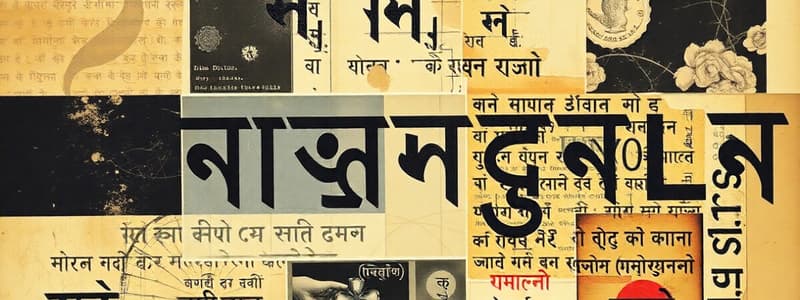Podcast
Questions and Answers
What language family does Bengali belong to?
What language family does Bengali belong to?
- Austroasiatic
- Sino-Tibetan
- Indo-Aryan (correct)
- Dravidian
In which region is Bengali predominantly spoken?
In which region is Bengali predominantly spoken?
- The Punjab region
- The Sindh region
- The Kerala region
- The Bengal region (correct)
Approximately how many people speak Bengali worldwide?
Approximately how many people speak Bengali worldwide?
- 250 million (correct)
- 75 million
- 150 million
- 25 million
From which ancient language did Bengali originate?
From which ancient language did Bengali originate?
Which of the following is a characteristic of Bengali's word order?
Which of the following is a characteristic of Bengali's word order?
Which term describes the Bengali writing system, where each consonant inherently carries a vowel sound?
Which term describes the Bengali writing system, where each consonant inherently carries a vowel sound?
Who was the first non-European to win the Nobel Prize in Literature?
Who was the first non-European to win the Nobel Prize in Literature?
What is the official language of Bangladesh?
What is the official language of Bangladesh?
In which Indian state is Bengali an official language, besides West Bengal?
In which Indian state is Bengali an official language, besides West Bengal?
What significant event is commemorated on February 21st as International Mother Language Day?
What significant event is commemorated on February 21st as International Mother Language Day?
Flashcards
What is Bengali?
What is Bengali?
An Indo-Aryan language spoken in the Bengal region, including Bangladesh and parts of India.
Origin of Bengali
Origin of Bengali
Magadhi Prakrit, an ancient Indo-Aryan language spoken in eastern India.
Three main periods of Bengali development
Three main periods of Bengali development
Old, Middle, and New Bengali.
Bengali as a syllabic language
Bengali as a syllabic language
Signup and view all the flashcards
Bengali Word Order
Bengali Word Order
Signup and view all the flashcards
Main Dialect Groups of Bengali
Main Dialect Groups of Bengali
Signup and view all the flashcards
Bengali Script as Abugida
Bengali Script as Abugida
Signup and view all the flashcards
Charyapada
Charyapada
Signup and view all the flashcards
Cultural Role of Bengali
Cultural Role of Bengali
Signup and view all the flashcards
First non-European Nobel Laureate in Literature
First non-European Nobel Laureate in Literature
Signup and view all the flashcards
Study Notes
- Bengali, also known as Bangla, is an Indo-Aryan language
- Spoken in the Bengal region of the Indian subcontinent
- The Bengal region comprises Bangladesh and the Indian states of West Bengal, Tripura, and parts of Assam
- Primary language spoken in Bangladesh
- Second most spoken language in India
- Approximately 250 million speakers worldwide, ranking it as one of the most spoken languages
Origin and Development
- Originated from Magadhi Prakrit, an ancient Indo-Aryan language spoken in eastern India
- Development divided into three main periods: Old Bengali (10th-13th centuries), Middle Bengali (14th-18th centuries), and New Bengali (19th century onwards)
- Old Bengali saw the emergence of the earliest Bengali literature, including the Charyapada
- Middle Bengali was marked by the influence of Persian and Arabic due to Muslim rule
- New Bengali developed with the influence of Western education and colonialism, leading to a standardization of the language
Linguistic Features
- Characterized by its unique phonetic inventory
- Wide range of vowels and consonants, including retroflex consonants
- Syllabic language, meaning that each syllable tends to have equal duration
- Follows a subject-object-verb (SOV) word order
- Nouns and pronouns are inflected for case and number
- Verbs are conjugated according to tense, aspect, and mood
- Rich system of honorifics, where different forms of address are used depending on social status and relationship between speakers
Dialects
- Exhibits significant dialectal variation
- Dialects can be broadly classified into four main groups: Rarhi, Bangali, Kamrupi, and Vanga
- Rarhi is the standard dialect spoken in West Bengal
- Bangali is spoken in Bangladesh and is different from the standard Bengali spoken in West Bengal
- Kamrupi dialects are spoken in northern Bengal and Assam
- Vanga dialects are spoken in southeastern Bengal
- Dialectal differences can be observed in pronunciation, vocabulary, and grammar
- The existence of diverse dialects sometimes poses challenges in communication between speakers from different regions
Writing System
- Uses its own writing system, known as the Bengali script
- The Bengali script is an abugida, meaning that each consonant letter inherently carries a vowel sound
- Other vowels can be indicated using diacritics
- Derived from the Brahmi script
- Shares similarities with other scripts used in the eastern Indian subcontinent, such as Assamese and Odia
- Has its own set of numerals
- The direction of writing is from left to right
Literature
- Has a rich history spanning over a thousand years
- The earliest examples of Bengali literature are the Charyapada, Buddhist mystical songs dating back to the 10th century
- During the Middle Bengali period, notable works included the Chandimangal and Manasamangal
- The 19th and 20th centuries witnessed a flourishing of Bengali literature, with prominent writers like Rabindranath Tagore, Kazi Nazrul Islam, and Sarat Chandra Chattopadhyay
- Rabindranath Tagore was the first non-European to win the Nobel Prize in Literature in 1913
- Modern Bengali literature continues to evolve with contemporary writers exploring diverse themes and styles
Cultural Significance
- Plays a vital role in the cultural identity of the Bengali people
- Symbol of Bengali nationalism and cultural pride
- Language Movement in 1952, where students protested for the recognition of Bengali as an official language of Pakistan, is a significant event in Bengali history
- The Language Movement is commemorated annually on February 21st, which is recognized as International Mother Language Day by UNESCO
- Used in various forms of cultural expression, including music, dance, drama, and cinema
- Cuisine is also an integral part of Bengali culture, with distinct flavors and culinary traditions
Bengali in Bangladesh
- Official language of Bangladesh
- Used in all spheres of public life, including government, education, and media
- The importance of Bengali in Bangladesh is deeply rooted in the country's history
- The struggle to preserve and promote the Bengali language was a key factor leading to the independence of Bangladesh in 1971
- The government of Bangladesh has taken various initiatives to promote the use of Bengali
- Initiatives include the establishment of Bengali language academies and the standardization of the Bengali script
Bengali in India
- One of the 22 official languages of India
- Official language of West Bengal, Tripura, and one of the official languages of Assam
- Widely spoken in other parts of India, particularly in urban centers
- The government of India has also taken steps to promote the use of Bengali
- These steps include the establishment of Bengali departments in universities and the promotion of Bengali literature and culture
Studying That Suits You
Use AI to generate personalized quizzes and flashcards to suit your learning preferences.




